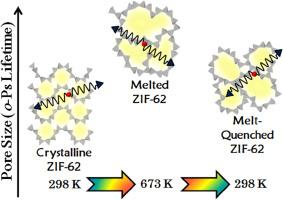沸石咪唑啉框架-62 熔体固有的多孔性导致形成多孔熔淬玻璃
IF 4.8
3区 材料科学
Q1 CHEMISTRY, APPLIED
引用次数: 0
摘要
沸石咪唑啉框架-62(ZIF-62)和 ZIF-4 等一些选择性金属有机框架经熔融淬火生成的多孔玻璃因其固有的多孔性、易加工性、高气体吸附能力和气体分离选择性而属于先进的功能材料。我们对结晶 ZIF-62 从室温(RT)到熔融态(> 熔点,Tm)的孔隙特征(孔径、孔径分布和孔隙密度)的热诱导变化进行了描述,随后在不同温度(RT-Tm)下进行了深度敏感的正电子湮没寿命光谱(PALS)原位测量。在真空下加热时,由于夹带溶剂分子的去除和不均匀热膨胀,ZIF-62 晶体的孔径和粒度分布增大到 473 K。在较高温度下(473 -573 K),由于长程有序性的丧失和体积塌缩,孔径和粒度分布都有所减小。熔化后,ZIF-62 变成了多孔液体,其孔隙比结晶体大 1.4 倍。这种多孔熔体的淬火是完全不可逆的,其结果是形成了一种多孔玻璃,其孔隙比结晶体大。原位 PALS 研究首次提供了 ZIF-62 熔体在高温下存在固有多孔性的实验证据,而这是之前通过 ZIFs 基熔体的分子动力学模拟所预测的。本文章由计算机程序翻译,如有差异,请以英文原文为准。

Inherent porosity of Zeolitic Imidazolate Framework-62 melt leading to formation of the porous melt-quenched glass
Porous glasses produced through melt-quenching of some selective metal organic frameworks like Zeolitic Imidazolate Framework-62 (ZIF-62) and ZIF-4 belong to the advanced functional materials because of their inherent porosity, ease of processing, high gas adsorption capacity and gas separation selectivity. We have delineated thermal induced modifications in the porosity features (pore size, size-distribution and pore density) of crystalline ZIF-62 from room temperature (RT) to its melt-state (> melting point, Tm) followed by its quenching, back to RT, carrying out the depth sensitive positron annihilation lifetime spectroscopy (PALS) measurements in-situ at varying temperatures (RT−Tm). On heating under vacuum, the pores' size as well as size-distribution of crystalline ZIF-62 increases up to ∼473 K as a consequence of removal of entrapped solvent molecules and nonuniform thermal expansion. At higher temperatures (∼473 −573 K), a reduction in pores’ size and size-distribution is observed due to the loss of long range ordering and volume collapse. On melting, ZIF-62 turns into a porous liquid having ∼1.4 times larger pores compared to its crystalline form. The quenching of this porous melt is fully irreversible, and results in the formation of a porous glass having the pores larger than its crystalline counterpart. The in-situ PALS investigation provides the first experimental evidence of inherent porosity in ZIF-62 melt existing at high temperature that has been predicted before through molecular dynamics simulation of the ZIFs-based melts.
求助全文
通过发布文献求助,成功后即可免费获取论文全文。
去求助
来源期刊

Microporous and Mesoporous Materials
化学-材料科学:综合
CiteScore
10.70
自引率
5.80%
发文量
649
审稿时长
26 days
期刊介绍:
Microporous and Mesoporous Materials covers novel and significant aspects of porous solids classified as either microporous (pore size up to 2 nm) or mesoporous (pore size 2 to 50 nm). The porosity should have a specific impact on the material properties or application. Typical examples are zeolites and zeolite-like materials, pillared materials, clathrasils and clathrates, carbon molecular sieves, ordered mesoporous materials, organic/inorganic porous hybrid materials, or porous metal oxides. Both natural and synthetic porous materials are within the scope of the journal.
Topics which are particularly of interest include:
All aspects of natural microporous and mesoporous solids
The synthesis of crystalline or amorphous porous materials
The physico-chemical characterization of microporous and mesoporous solids, especially spectroscopic and microscopic
The modification of microporous and mesoporous solids, for example by ion exchange or solid-state reactions
All topics related to diffusion of mobile species in the pores of microporous and mesoporous materials
Adsorption (and other separation techniques) using microporous or mesoporous adsorbents
Catalysis by microporous and mesoporous materials
Host/guest interactions
Theoretical chemistry and modelling of host/guest interactions
All topics related to the application of microporous and mesoporous materials in industrial catalysis, separation technology, environmental protection, electrochemistry, membranes, sensors, optical devices, etc.
 求助内容:
求助内容: 应助结果提醒方式:
应助结果提醒方式:


